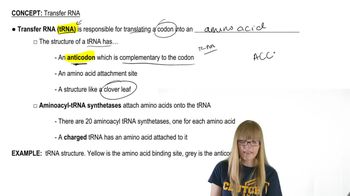Table of contents
- 1. Introduction to Genetics51m
- 2. Mendel's Laws of Inheritance3h 37m
- 3. Extensions to Mendelian Inheritance2h 41m
- 4. Genetic Mapping and Linkage2h 28m
- 5. Genetics of Bacteria and Viruses1h 21m
- 6. Chromosomal Variation1h 48m
- 7. DNA and Chromosome Structure56m
- 8. DNA Replication1h 10m
- 9. Mitosis and Meiosis1h 34m
- 10. Transcription1h 0m
- 11. Translation58m
- 12. Gene Regulation in Prokaryotes1h 19m
- 13. Gene Regulation in Eukaryotes44m
- 14. Genetic Control of Development44m
- 15. Genomes and Genomics1h 50m
- 16. Transposable Elements47m
- 17. Mutation, Repair, and Recombination1h 6m
- 18. Molecular Genetic Tools19m
- 19. Cancer Genetics29m
- 20. Quantitative Genetics1h 26m
- 21. Population Genetics50m
- 22. Evolutionary Genetics29m
11. Translation
Transfer RNA
Problem 11a
Textbook Question
Consider translation of the following mRNA sequence: 5′-...AUGCAGAUCCAUGCCUAUUGA...-3′ What events occur to permit the next tRNA to interact with mRNA?
 Verified step by step guidance
Verified step by step guidance1
Identify the start codon in the mRNA sequence, which is typically 'AUG'. This codon signals the beginning of translation and codes for the amino acid methionine.
Recognize that the ribosome binds to the mRNA at the start codon, facilitating the assembly of the translation machinery.
Understand that the ribosome has three sites: the A (aminoacyl), P (peptidyl), and E (exit) sites. The initiator tRNA carrying methionine binds to the P site.
The next tRNA, carrying an amino acid corresponding to the next codon on the mRNA, will enter the A site of the ribosome.
Ensure that the anticodon of the incoming tRNA is complementary to the mRNA codon in the A site, allowing for proper base pairing and continuation of the translation process.
Recommended similar problem, with video answer:
 Verified Solution
Verified SolutionThis video solution was recommended by our tutors as helpful for the problem above
Video duration:
4mPlay a video:
Was this helpful?
Key Concepts
Here are the essential concepts you must grasp in order to answer the question correctly.
Translation Process
Translation is the process by which ribosomes synthesize proteins using mRNA as a template. It involves three main stages: initiation, elongation, and termination. During elongation, tRNA molecules bring amino acids to the ribosome, matching their anticodons with the codons on the mRNA strand, facilitating the assembly of a polypeptide chain.
Recommended video:
Guided course

mRNA Processing
tRNA Structure and Function
Transfer RNA (tRNA) is a type of RNA that carries amino acids to the ribosome during protein synthesis. Each tRNA molecule has a specific anticodon that pairs with a corresponding codon on the mRNA, ensuring the correct amino acid is added to the growing polypeptide chain. The interaction between tRNA and mRNA is crucial for accurate translation.
Recommended video:
Guided course

Functional Genomics
Ribosome Function
Ribosomes are the cellular machinery responsible for protein synthesis. They consist of ribosomal RNA (rRNA) and proteins, forming two subunits that come together during translation. The ribosome facilitates the binding of tRNA to mRNA, ensuring that the correct sequence of amino acids is assembled according to the genetic code encoded in the mRNA.
Recommended video:
Guided course

Ribosome Structure
Related Videos
Related Practice




